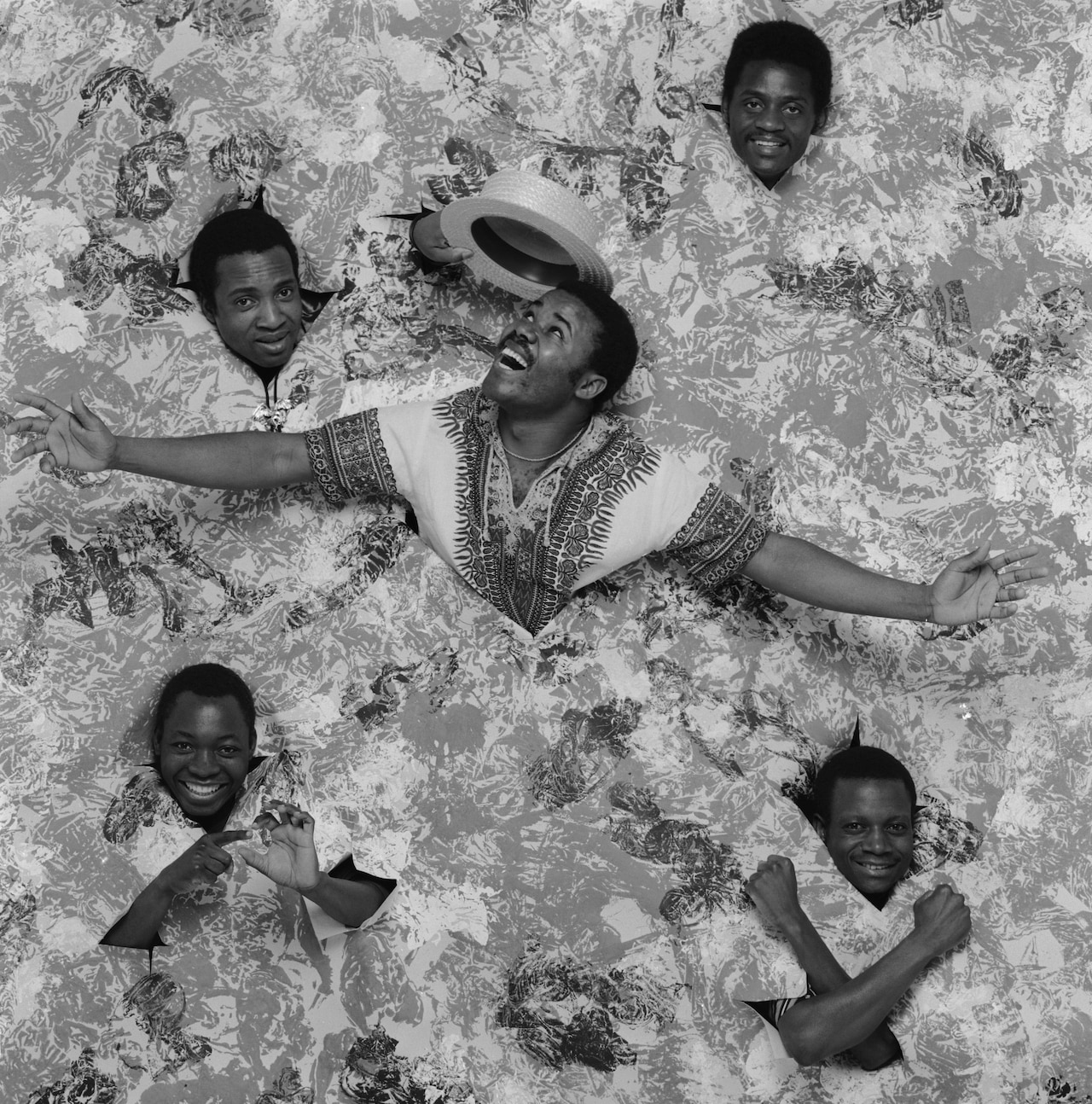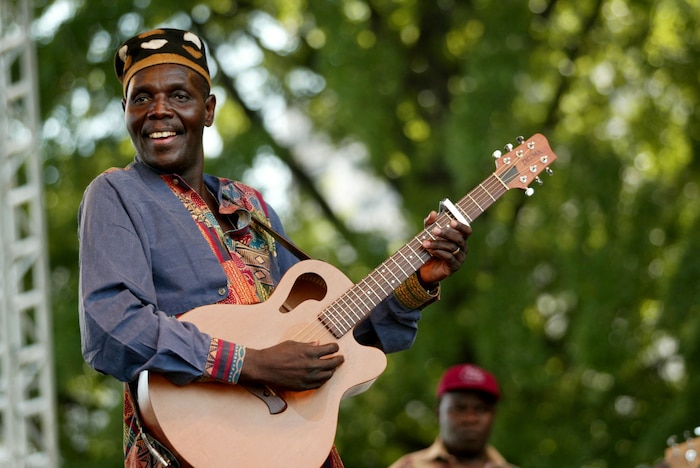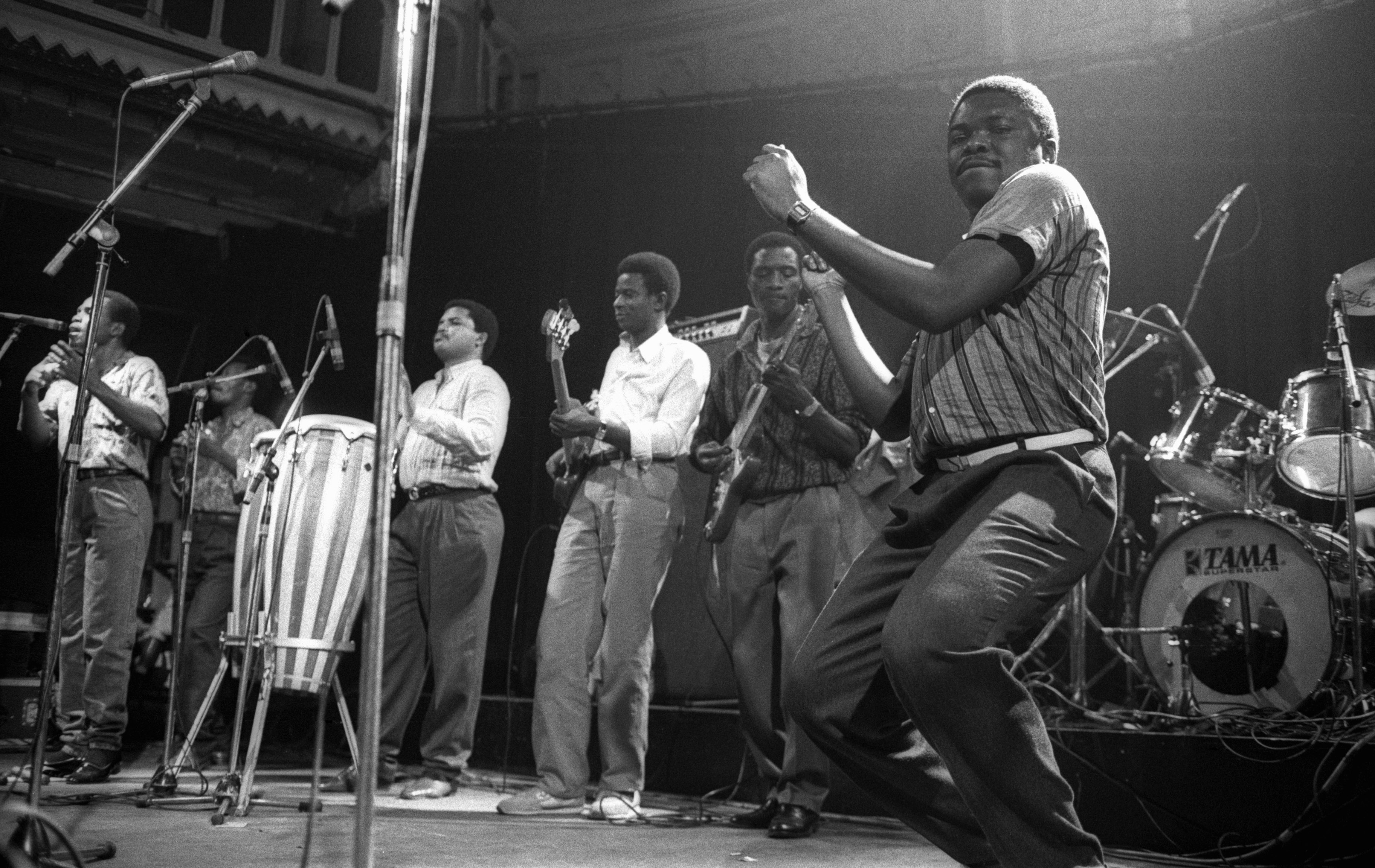
Liberation and Loss: The Tangled History of Zimbabwean Music
A primer into the jit, chimurenga, sungura, Tuku sound and mbira pop of post-independence Zimbabwe – and how the music fared in the face of political turmoil, public health crises and personal tragedy
In 1986, a group of five young Zimbabwean musicians called the Bhundu Boys arrived in the UK for their first foreign tour. They had the charisma of a young Beatles, reflected in soulful vocal harmonies, exuberantly enmeshed electric guitars, pumped-up grooves, synchronized stage moves and hook-laden songs that easily transcended the language barrier. The band ended up touring the UK for a full year, earning rave reviews for their club shows, repeat bookings at Glastonbury Festival, praise and airtime on the BBC from the most respected music champions of the day, Andy Kershaw and John Peel – who infamously shed tears of joy upon seeing them live – and, ultimately, a slot at Wembley Stadium propping up Elvis Costello, Eric Clapton and Madonna. The Bhundu Boys called their music “jit” in interviews, though they had a hard time pinning down a precise meaning for the term. It seemed to fit the infectious itch of their music pretty much spot on, so it stuck.
In 1991 came Jit, a movie starring Zimbabwean superstar Oliver Mtukudzi, and so it was that African music fans in Europe and North America came to know the entire panorama of guitar-based Zimbabwean pop music in general as jit. In fact, jit, or jiti, has been used to describe all sorts of Zimbabwean music since at least the 1950s. In the early 1970s, broadcasters and librarians at the colonial Rhodesian Broadcasting Corporation (RBC) knew jit as lively, dance-drumming songs performed in Shona villages.
They were typically nimble, gliding along in 12/8 time with I-IV-I-V harmonic progressions that likely owe something to the hymns and songs sung in colonial-era churches. They focused on matters of daily life, accompanied by anything from gourd shakers and ngoma hand drums to an array of acoustic guitars. Curiously, the word jit isn’t even found in the Shona language. It came from South Africa – along with terms such as jive, marabi and tsava-tsava – describing a feeling of giddiness and celebration rather than an identifiable set of musical characteristics.
In the early 1970s, Zimbabwe’s pop scene was taking shape. South Africa’s Gallo Records had established branches in Bulawayo and Salisbury (soon to become Harare) under the name Teal Records. Initially the label focused on African jazz acts out of Bulawayo, but in 1971, Zexie Manatsa and the Green Arrows released a guitar-driven Shona pop song called “Chipo Chiroorwa” – that is to say, “Chipo, it’s time you got married.” When the song took off, Teal followed up with similar fare from an emerging cluster of groups including The Great Sounds, O.K. Success, M.D. Rhythm Success, the Harare Mambos, the Hallelujah Chicken Run Band and the Acid Band – the latter two linked by a soon-to-be icon, Thomas Mapfumo.
These bands were to varying degrees shaped by two external influences. First was the powerful township jive emanating from South Africa, with its strong four-on-the-floor heartbeat pulse and forcefully harmonized vocals. Bulawayo acts, notably Lovemore Majaivana, created a local variant of the jive sound, generally singing in Ndebele, the language of the Matabeleland region that surrounds Bulawayo and borders South Africa. The other, more significant, influence came from the north, the sensuous rumba music emanating out of Kinshasa and Brazzaville, two cities facing each other across the Congo River.
The Congolese sound was built around the Cuban clave time line – the 3-2 beat combination that builds an undulating call-and-response structure deep into the song’s architecture. Congolese rumba was polished guitar pop, featuring meticulously arranged solo and choral vocals and dance grooves that intensified throughout sometimes lengthy compositions. Some hewed close to the Congolese formula; others sang in Shona, seeking to adapt their Shona heritage as well as putting a local spin on what was borrowed from South Africa and the Congo.
That original village groove was reconceived in jit: Typically, a trap drummer would play four main beats on the bass drum, and overlay a triplet feel on hi-hat. This technique would quickly become a sonic fixture of the emerging Zimbabwean guitar-band boon. During the most intense war years of the late 1970s, and even more so after Zimbabwe’s independence in 1980, regional pop dominated over international imports. Filled with the excitement of achieving liberation, Zimbabweans were swept up in celebration of their roots, and the intoxicating feeling of a new identity taking shape.
Thomas Mapfumo’s set during independence celebrations in Harare, as chimurenga guerillas danced in the dust with their AK-47s, was the beginning of an impressive revival that would see him dubbed the saviour of Shona music.
In that context, a truly local instrument took central prominence, the Shona mbira: a handheld, metal-pronged instrument used in spirit possession ceremonies. The singer and band-leader Thomas Mapfumo led a movement to adapt this sacred trance music – handily, almost always in 12/8 time – to trap drums, bass and electric guitars. From his emergence as a songwriter in the early 1970s, Mapfumo’s songs were also subversively political, implicitly supporting the guerrilla forces then fighting to liberate the country from Rhodesian settler rule. Mapfumo called his music chimurenga, the term fighters used for the liberation war, and the name stuck.
Flash to April 1980, and Harare’s Rufaro Stadium is awash with elation. The inaugural Independence Day celebrations are mostly remembered for pomp and circumstance, though not without flashes of conflict: Bob Marley’s performance was temporarily paused as the stadium gates were charged by crowds intent on seeing the reggae superstar, and tear gas filled the air. Thomas Mapfumo was kept for last, an act of calculated humiliation. Mapfumo had run afoul of the incoming regime when forced to play at a 1979 political rally for an opposing (and accommodationist) presidential candidate, Archbishop Abel Muzorewa. Yet Mapfumo’s set for chimurenga guerillas, dancing in the dust at daybreak with their AK-47s, was the beginning of an impressive revival that would see him dubbed the saviour of Shona music.
Mapfumo’s songs of triumph chimed with the country’s newfound drive and its reclamation of national, and pan-African, pride. The Four Brothers, headed by Mapfumo’s uncle, drummer and vocalist Marshall Munhumumwe, broke big with their landmark hit “Makorokoto (Congratulations),” recirculated on the airwaves as a nod toward victorious freedom fighters. Lauding the achievements of the struggle was pretty much de rigueur for Zimbabwean acts in the early ’80s, but in a nation ever more buoyed by its hard-won freedom, the mood would move steadily away from reflection on the past to enjoyment of the moment.
Thomas Mapfumo and Oliver Mtukudzi, who had briefly toured together in the mid-’70s in a band called Wagon Wheels, were early champions of a movement to sing in Shona rather than English. From 1978 onward, Mapfumo developed his mbira-based chimurenga style with his own band, the Blacks Unlimited. Mtukudzi, with his band the Black Spirits, blended Zimbabwean traditional rhythms, such as that of the Korekore tribe, with South African township elements to create his own namesake Tuku sound. As Mapfumo and Mtukudzi surged ahead on their own paths, another distinct and durable genre that would be shared by generations of Zimbabwe guitar bands began blossoming, too.
Sungura is a style of music and dance that exiles and fighters who had spent the war years in Kenya and Tanzania returned to popularize in the newly-christened Zimbabwe. The word sungura, meaning “rabbit” in Kiswahili, is a rumba variant that de-emphasizes the Cuban clave feel, instead following the lead of East African sounds like Kenyan benga. There, lead and accompaniment guitars have more equal prominence, as opposed to the rigidly stratified approach in Congolese rumba, where the lead guitarist is king. Sungura guitars, bass included, are playfully interactive, foregrounding and backgrounding one another by turns. The song subjects tend to be light and humorous, tales of ill-fated infidelity and romantic angst. Sungura stars include James Chimombe, Leonard Dembo, System Tazvida and the current leader of the genre, Alick Macheso. For the entirity of Zimbabwe’s post-colonial history, sungura has remained by far the biggest selling local music in the country, continuing to outstrip the competing contemporary sounds of Zim dancehall and hip-hop – a testament to the intractable sense of national pride.
Andy Kershaw, whose support had been vital to the Bhundu Boys’ early exposure, said that the major label suits that decided to Anglicize and sanitize the group should be “taken out and put to death.”
Yet this attitude is curiously not mirrored in the Zimbabwean state-controlled media. Mapfumo has been a noted critic of the radio in particular, decrying the way elitist broadcasters cast local music as less appealing than foreign styles, by relegating all artists, regardless of worthiness, to Radio 2 while international music and current affairs swarm the main bandwidth. Even the nomenclature was careless: starting in the early ’80s, Radio 2 DJs began loosely referring to all of the emerging guitar band pop styles under the umbrella term “jit,” which fans latched onto in turn.
This set the stage for the Bhundu Boys’ appropriation of the tag, a factor in their wildfire success. On their first two albums, 1986’s Shabini and 1987’s Tsvimbodzemoto, the Bhundus actually drew upon a wider number of styles that they were credited for: mbira adaptations, rumba, sungura and township jive. But jit was a handy catch-all, a way to make inroads internationally. On the strength of those albums and their incandescent live performances, the Bhundus became the first Zimbabwean pop band to tour the US in 1988. But their next LP, True Jit, switched to the English language, toned down the energy and smothered the band’s nimble guitar work in overly glossy production. Andy Kershaw, whose support had been vital to the Bhundu Boys’ early exposure, said that the major label suits that decided to Anglicize and sanitize the group should be “taken out and put to death.”
The situation back home was a similar tangle of highs and lows. By the tail-end of the ’80s, Harare had expanded into a metropolis of townships and “growth points,” full of beerhalls and outdoor performance spaces frequently packed with urbanites for whom live music and beer offered an irresistible escape from life’s travails. Performers rarely ended their shows before 3:30 AM, and if it was billed as a “pungwe” – a reference to the all-night musical teach-ins of the war years – then the music would last until sunrise. All across the city, revelers could spend the weekend dancing to high-adrenaline sungura, such as Leonard Dembo’s ubiquitous 1992 hit “Chitekete” – a song whose message, about the obstacles a poor man faces in order afford marriage, did not deter it from becoming a wedding disco staple.
But by the end of the ’90s, the scene was darkening. A staggering 40% of the adult population had been diagnosed with HIV, although it remained taboo for musicians to acknowledge this publicly. It was this public health disaster that put out the light for the country’s brightest hopes: Between 1991 and 1993, three members of the Bhundu Boys died from AIDS-related diseases, with Biggie Tembo’s suicide in a psychiatric hospital following in 1995.
This deleterious decline was made worse by government corruption and misrule under Robert Mugabe, whose reforms were sinking the economy. For Mapfumo and Mtukudzi – both constants on the Harare circuit, singing robust, reverential songs preaching positive morality and pro-African sentiments – the global market was a handy lifeline. But for others, forced to shimmy up the ladder in increasingly desperate and dangerous beerhalls, the crowds were thinning. State radio programmers still championed music from abroad. When the Minister of Information imposed a 75% broadcast quota for Zimbabwean music, DJs balked, making up the numbers by playing the local material late at night when few were listening. Cassette piracy further eroded the earning power of local artists. Fans continued to support live music, but the party was much diminished.

A number of groups over the years have tried to break through with their own take on the mbira pop sound. These include Pio Macheka and the Black Ites, Ephat Mujuru’s Spirit of the People, Jonah Sithole and Vadzimba – the last the only one that survives to this day. But even in their truncated lifetimes, none of these groups managed to escape Mapfumo’s shadow and establish durable careers of their own. They are often dismissed either as Mapfumo imitators, but perhaps more importantly, none have shown his talent for provocative, topical songwriting.
That provocation did not exactly serve Mapfumo well, however. In 1988, “Corruption” marked his first break with the Mugabe regime. A decade later, when radio hosts were intimidated into keeping scathing anti-government screeds “Mamvemve (Tatters)” and “Disaster” off the airwaves, the gloves were off. Mapfumo moved his family into exile in Oregon in 2000, and did not perform in Zimbabwe between 2004 and 2018, only returning when Mugabe had finally released his grip on power. Even in exile, Mapfumo continued to stir the political pot with songs like 2002’s “Marima Nzara (You Have Harvested Hunger),” a bitter condemnation of Mugabe’s chaotic land reform efforts, and 2004’s “Masoja ne Mapurisa (The Soldiers and the Police),” an attack on vigilante police actions. This in turn inspired government thugs to raid flea markets and music stalls where the song was being sold, underscoring Mapfumo’s point, and the singular influence of his voice.
While no other Zimbabwean act of the past three decades has emerged to rival Mapfumo and Mtukudzi, nor the nearly-weres of the Bhundu Boys, a group from Victoria Falls called Mokoomba carry the spirit of Zimbabwe’s febrile post-war creative boom. Mokoomba’s music draws from many sources: Rumba, mbira, folk songs of marginalized ethnic groups in northern Zimbabwe and even Mande music from Mali. The band’s youthful energy give an additional edge to their varied grooves, inviting natural comparisons to the Bhundus. However, Mokoomba would never describe their music as jit, a term that feels positively antiquated in today’s environment.
Zimbabweans of the “born free” generation increasingly see these guitar-based genres as part of the past. They are revered, but not of the moment. Contemporary tastes have shifted increasingly to the Zim dancehall sound championed by stars like the self-ascribed “Bigman,” Winky-D. For Zimbabwean music aficionados, this musical cross-pollination is seen as a further dilution of authentic, fiercely original local roots by a competing foreign aesthetic, harking back to the same struggles that pockmarked broadcast media in the 1980s. There is also another dimension that links the current school of stars to the past: owing to his support for Nelson Chamisa, the current leader of the oppositional Movement for Democratic Change, Winky-D was barred from the recent funeral of Oliver Mtukudzi on political grounds. It goes to show that the more things change in Zimbabwe’s musical landscape, the more they stay the same.
Header image © Steve Pyke/Getty Images

